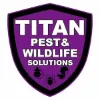To avoid pests like mosquitoes, bees, ants, and aphids, there are several plants and flowers you must avoid planting in your yard.
Many people enjoy having beautiful flowers and plants around their yard and patio. Most of us choose plants based on what we think is pretty, what we can afford, and how much sunlight the area we’re planting them in gets.
But what about choosing plants based on what bugs they attract? Some plants repel certain types of bugs, while others attract them. Therefore, to avoid pests like mosquitoes, bees, ants, and aphids, there are several plants and flowers you must avoid planting in your yard.

At Titan Pest & Wildlife, we specialize in managing and eradicating pests that can infest your home, business, or outdoor areas. If you have pest control problems, contact us today.
10 Plants and Flowers to Avoid
Here are some plants and weeds that you may want to avoid or manage carefully to prevent an overwhelming presence of undesirable insects in your yard:
- Ivy: While ivy can add a touch of greenery to walls or fences, it attracts certain pests, such as aphids and scale insects. These sap-sucking insects can multiply rapidly and weaken the plant over time. If you choose to have ivy in your yard, regularly monitor it for infestations and take appropriate measures to control them.
- Sweet Alyssum: This is a charming ground cover with small, fragrant flowers that attract insects, including aphids and whiteflies. These pests can quickly reproduce and damage other nearby plants. If you opt for sweet alyssum, keep a close eye on it and take steps to prevent pest outbreaks.
- Butterfly Bush: While butterfly bushes are renowned for attracting butterflies, they can also lure in other insects that may become problematic. In particular, the butterfly bush can attract aphids and spider mites, which can infest and harm nearby plants. Regular pruning and monitoring can help keep these pests in check.
- Japanese Beetles Magnets: Plants like roses, linden trees, grapes, and raspberries are beautiful to Japanese beetles. These voracious pests can defoliate plants if their populations are left uncontrolled. Consider alternative plants or implement measures like physical barriers or organic controls to manage Japanese beetle populations.
- Russian Sage: Russian sage is a beautiful perennial with aromatic foliage and lavender-colored flowers. However, it can attract spider mites, which can cause damage by feeding on the plant’s sap. Regularly inspect your Russian sage for signs of spider mite infestation and take appropriate action to address the issue promptly.
- Daylilies: Daylilies are famous for their vibrant blooms, but they can be magnets for aphids. These small, sap-sucking insects can multiply rapidly and weaken the plants over time. To manage aphids on daylilies, consider natural predators like ladybugs or regular applications of organic insecticidal soap.
- Bamboo: While bamboo can add an exotic touch to your yard, it can be a haven for mosquitoes. Bamboo can hold water in its hollow stems, providing breeding grounds for these pesky insects. If you have bamboo in your yard, regularly inspect and clean the stems to prevent stagnant water accumulation.
- Honeysuckle: Honeysuckle vines are known for their sweet fragrance, attracting bees, aphids, and other sap-sucking pests. These insects can damage the plant and spread to neighboring vegetation. Regular pruning and monitoring can help control aphid populations and minimize their impact.
- Mint: Mint is a popular herb with a strong aroma but can be attractive to ants and aphids. These pests can infest and damage the mint plant and potentially spread to nearby crops. Consider planting mint in containers to restrict its growth and minimize the risk of pest infestations.
- Wisteria: Wisteria is a stunning flowering vine, but it can become a haven for caterpillars, including the larvae of the wisteria moth. These caterpillars can defoliate the plant if their populations become too high. Regular inspection and manual removal of caterpillars can help prevent significant damage.
While creating an environment that attracts beneficial insects is important, managing plants and weeds that attract unwanted bugs is crucial to maintaining a balanced ecosystem.
Pest Control Services
No matter how careful you are about the plants and flowers you choose, bugs are always around. When they become problematic, it’s time to call pest control services. From identifying the type of pests you have and where they’re coming from to ongoing pest management programs to prevent future infestations, we offer complete pest control solutions.

